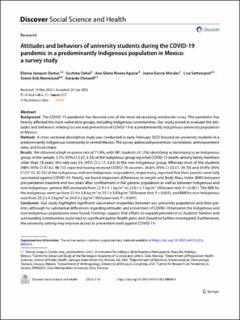| dc.contributor.author | Joaquin Damas, Elienai | |
| dc.contributor.author | Dahal, Sushma | |
| dc.contributor.author | Rivera Aguilar, Ana Gloria | |
| dc.contributor.author | Garcia Morales, Juana | |
| dc.contributor.author | Sattenspiel, Lisa | |
| dc.contributor.author | Mamelund, Svenn-Erik | |
| dc.contributor.author | Chowell, Gerardo | |
| dc.date.accessioned | 2023-11-29T13:23:20Z | |
| dc.date.available | 2023-11-29T13:23:20Z | |
| dc.date.created | 2023-08-04T14:24:05Z | |
| dc.date.issued | 2023 | |
| dc.identifier.issn | 2731-0469 | |
| dc.identifier.uri | https://hdl.handle.net/11250/3105239 | |
| dc.description.abstract | Background The COVID-19 pandemic has become one of the most devastating worldwide crises. The pandemic has heavily affected the most vulnerable groups, including Indigenous communities. Our study aimed to evaluate the atti- tudes and behaviors relating to care and prevention of COVID-19 in a predominantly Indigenous university population in Mexico.
Methods Across-sectionaldescriptivestudywasconductedinearlyFebruary2022focusedonuniversitystudentsina predominantly Indigenous community in central Mexico. The survey addressed prevention, vaccination, anthropometric data, and food intake.
Results Weobtainedahighresponserateof71.6%,with981students(41.2%)identifyingasbelongingtoanIndigenous group. In the sample, 3.1% (95% CI 2.07, 4.33) of the Indigenous group reported COVID-19 deaths among family members older than 18 years; this rate was 3% (95% CI 2.17, 4.03) in the non-Indigenous group. Whereas most of the students [98% (95% CI 97.62, 98.72)] reported having received COVID-19 vaccines, 36.6% (95% CI 33.57, 39.70) and 39.9% (95% CI (37.32, 42.52) of the Indigenous and non-Indigenous respondents, respectively, reported that their parents were fully vaccinated against COVID-19. Finally, we found important differences in weight and Body Mass Index (BMI) between pre-pandemic baseline and two years after confinement in the general population as well as between Indigenous and non-Indigenous: general BMI increased from 22.9 ± 4.1 kg/m2 to 23.6 ± 4.1 kg/m2 (Wilcoxon test; P < 0.001). The BMI for the Indigenous went up from 22.4 ± 3.8 kg/m2 to 23.1 ± 3.8 kg/m2 (Wilcoxon test; P < 0.001), and BMI for non-Indigenous rose from 23.2 ± 4.2 kg/m2 to 24.0 4.2 kg/m2 (Wilcoxon test; P < 0.001).
Conclusion Our study highlights significant vaccination disparities between our university population and their par- ents, although no substantial differences regarding attitudes and prevention of COVID-19 between the Indigenous and non-Indigenous populations were found. Findings suggest that efforts to expand prevention to students’ families and surrounding communities could lead to significant public health gains and should be further investigated. Furthermore, the university setting may improve access to prevention tools against COVID-19. | en_US |
| dc.language.iso | eng | en_US |
| dc.relation.uri | https://link.springer.com/article/10.1007/s44155-023-00050-4 | |
| dc.rights | Navngivelse 4.0 Internasjonal | * |
| dc.rights.uri | http://creativecommons.org/licenses/by/4.0/deed.no | * |
| dc.title | Attitudes and behaviors of university students during the COVID-19 pandemic in a predominantly Indigenous population in Mexico: a survey study | en_US |
| dc.type | Peer reviewed | en_US |
| dc.type | Journal article | en_US |
| dc.description.version | publishedVersion | en_US |
| cristin.ispublished | true | |
| cristin.fulltext | original | |
| cristin.qualitycode | 1 | |
| dc.identifier.doi | 10.1007/s44155-023-00050-4 | |
| dc.identifier.cristin | 2164917 | |
| dc.source.journal | Discover Social Science and Health | en_US |
| dc.source.volume | 3 | en_US |
| dc.source.issue | 1 | en_US |
| dc.relation.project | Senter for grunnforskning: Social Science Meets Biology | en_US |

